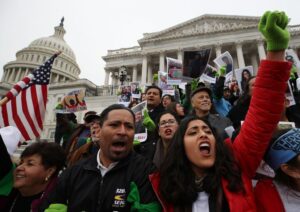The Fed held key interest rates steady again Wednesday, as expected, and signaled that a decision that could affect everything from credit card rates to the housing market to new business creation could still be months away.
It was the fourth consecutive time the central bank has left the rate unchanged since its September 2023 announcement. In March 2022, the Fed began aggressively raising rates to stop ballooning inflation.
Following the announcement, Federal Reserve Chair Jerome Powell said that confidence is growing that inflation is coming down to meet the Fed’s target of 2%, it needs to see more data to decide to cut rates, particularly in the 12-month core inflation data.
But Powell said its confidence likely won’t be strong enough to cut rates by March as many economists believed would happen, meaning it could be May before a decision is made to cut rates.
“I think to get to that place where we feel comfortable starting the process we need some confirmation that inflation is in fact coming down, sustainably to 2%,” Powell said.
Powell added that serious changes to the labor market would affect the Fed’s decisions about when to cut rates.
“If we saw an unexpected weakening certainly in the labor market, that would weigh on cutting sooner,” he said. “And if we saw inflation being stickier or higher, or those sorts of things, we’d argue for moving later.”
The decision to hold rates steady was in line with economists’ expectations for the meeting. The issue of when to stop increasing rates and when to begin cutting rates, to avoid harming the economy and cause high unemployment, has been a matter of intense debate among economists and policymakers during this latest cycle of rate hikes. ver the past six months, core inflation or the Personal Consumption Expenditures price index is 1.9%, leading some economists to argue that it’s time to begin cutting rates.
Konczal said it would make sense for the Fed to begin cutting rates soon.
“[A cut] is appropriate given how much inflation has fallen, both faster and in a more broad way than the Federal Reserve thought even six or nine months ago,” said Mike Konczal, director of macroeconomic analysis at the Roosevelt Institute, a progressive think tank. “The Fed is targeting a level of inflation that is just not the reality right now in the economy.”
The Federal Reserve has a pivotal decision to make in the coming months — when to start cutting interest rates after an aggressive campaign of rate hikes to combat inflation. Some economists worry that if the Fed doesn’t cut rates soon enough, now that the rise in core inflation over the past six months is in line with the Fed’s 2% inflation target, it could damage the labor market and send ripples through the economy.
There is some risk to waiting too long to cut rates, Konczal said. Although the economy is adding jobs and decent wage growth continues, he’s looking for signs of cracks underneath the surface of an otherwise stable labor market. He said that the rate for people leaving their jobs and being hired for new ones has slowed.
If the Fed waits too long to change course, he said there could be some danger of the unemployment rate ticking up too fast.
“Once those things start to fall, they fall very quickly,” he said.
Several Democratic senators have urged the Fed to begin cutting rates, arguing that it could hurt the economy not to do so as soon as possible, a reminder that the economy will be a big issue in the fall elections. Sen. Sherrod Brown (D-OH) , chair of the Senate Committee on Banking, Housing, and Urban Affairs advocated for Powell to lower rates in a letter addressed to the chairman this week.
Brown wrote his own letter, which highlighted the struggles of Ohioans he said are not able to rent or buy homes, a problem he said has been exacerbated by higher interest rates.
“I hear from so many Ohioans that they feel trapped – those who rent feel like they’ll never be able to afford to buy and those who already own their homes feel like they will never be able to afford a larger one if they decide to grow their family,” Brown wrote.
Sometime after the Fed cuts rates, Americans can expect to see relief in the housing market, where homeowners have struggled with low housing supply and high prices, and high demand for rentals that has also pushed up rental prices.
“The first place where we see the reaction in the economy is the housing market and is in those mortgage applications, like some refinancing, for example,” Lara Rhame, chief U.S. economist and managing director of FS Investments. “The other places we see it are things like auto sales, which are very interest-rate sensitive. It’s worth noting that credit card interest payments have really increased, but that doesn’t move until the Fed actually cuts rates. That’s a shorter term interest rate, but when the Fed cuts, that will start to come down a little bit.”
William Hauk, associate professor of economics at the University of South Carolina, said it could take a while for the average person to feel a shift in the economy as a result of Fed policy changes.
“How quickly this translates into changes for the rest of the economy is a matter of some debate. Making it easier for people and firms to borrow and/or refinance loans does typically have a positive impact on economic demand,” he said. “And people spending money is good for keeping the economy out of recession. However, this effect typically hits the broader economy with a lag, perhaps as long as 12 to 18 months.”
Our stories may be republished online or in print under Creative Commons license CC BY-NC-ND 4.0. We ask that you edit only for style or to shorten, provide proper attribution and link to our website. AP and Getty images may not be republished. Please see our republishing guidelines for use of any other photos and graphics.





